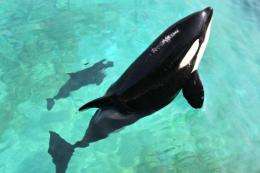Killer whales migrate, study finds, but why?

Some killer whales, a study published Wednesday shows for the first time, wander nearly 10,000 kilometres (6,200 miles) from Antarctica's Southern Ocean into tropical waters -- but not to feed or breed.
Rather, these fearsome predators at the apex of the marine food chain traverse the sea at top speed -- slowing as they reach warmer climes -- to exfoliate, the study speculates.
They are driven, in other words, by the urge or need to make their skin all shiny and new.
Despite our intense fascination with seal-chomping orcas, next to nothing was known about their long-haul movements, or whether they migrate at all.
To find out more, John Durban and Robert Pitman of the US National Marine Fisheries Service fitted a dozen so-called "type B" killer whales off the west coast of the Antarctic Peninsula with satellite transmitters.
In January 2009, the scientists used bolt-shooting crossbows to attached tags to the five-tonne mammals' dorsal fins from a distance of five to 15 metres (15 to 50 feet).
"Type B" orcas inhabit the inshore waters of Antarctica near pack ice, the better to feed on seals and penguins. Type A killer whales prefer open water and a diet of minke whales, and the smaller, fish-eating type C is most common in the eastern Antarctic.
Half the satellite tags stopped working after three weeks, but the remaining six revealed a remarkable and unexpected wanderlust over the following two years.
"Our tagged whales followed the most direct path to the nearest warm waters north of the subtropical convergence, with a gradual slowing of swim speed in progressively warmer water," the authors note.
The whales made a beeline, cruising at up to 10 km/hr (six mph), across the southwest Atlantic east of the Falkland Islands to the subtropical waters off the coasts of Uruguay and southern Brazil.
The study, published in the British Royal Society's journal Biology Letters, provides the first direct evidence of long-distance migration by killer whales.
But why they do it remains something of a mystery.
The speed and duration of the voyages, undertaken individually, did not leave enough time for prolonged foraging, and would have been too demanding for a new-born calf.
"Remarkably, one whale returned to Antarctica after completing a 9,400 kilometre (5,840 mile) trip in just 42 days," the study said.
The varied departure dates, between early February and late April, also suggested these expeditions were not annual migrations for feeding or breeding.
Which is where skin comes into the picture.
Durban and Pitman suspect that killer whales move into warmer waters in order to shed a layer -- along with an encrustation of single-celled algae called diatoms -- without freezing to death.
Orcas are the smallest cetaceans -- a group including whales and dolphins -- which live for extended periods in subzero Antarctic waters. Replacing and repairing outer skin in waters where the surface temperature is minus 1.9 degree Celsius (28.6 degree Fahrenheit) may be dangerous, even lethal.
Surface temperatures at the killer whales' tropical destinations, by contrast, were a balmy 20.9 to 24.2 C (69.6 to 75.6 F).
"We hypothesise that these migrations were thermally motivated," the authors conclude.
Killer whales (Orcinus orca) are the most widely distributed cetacean -- and perhaps mammal species -- in the world.
(c) 2011 AFP
















